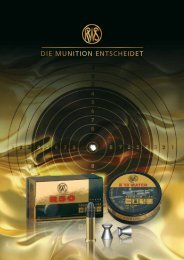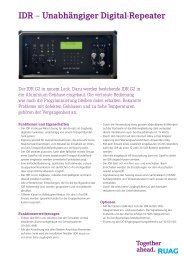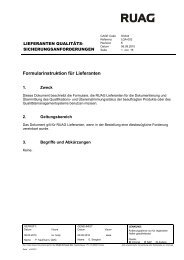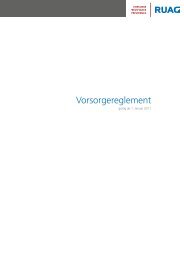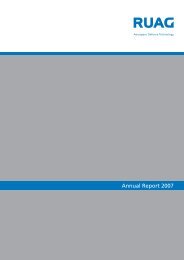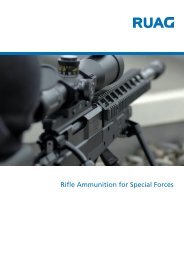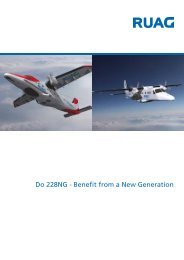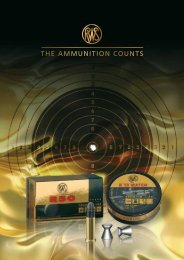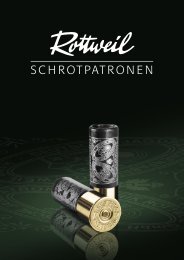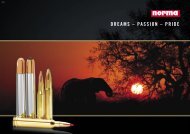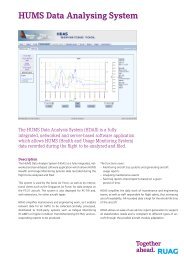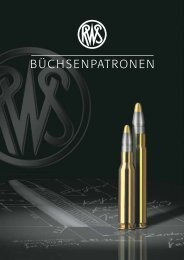Guidance, Navigation and Control Systems for Sounding Rockets
Guidance, Navigation and Control Systems for Sounding Rockets
Guidance, Navigation and Control Systems for Sounding Rockets
You also want an ePaper? Increase the reach of your titles
YUMPU automatically turns print PDFs into web optimized ePapers that Google loves.
<strong>Guidance</strong>, <strong>Navigation</strong> <strong>and</strong><br />
<strong>Control</strong> <strong>Systems</strong> <strong>for</strong> <strong>Sounding</strong> <strong>Rockets</strong><br />
With more than 30 years of experience in sounding rocket guidance,<br />
navigation <strong>and</strong> control, RUAG Space provides systems <strong>for</strong> sounding<br />
rockets, with peak altitudes in the 100-1000 km range <strong>and</strong> more.<br />
S19 controlled liftoff<br />
The S19L<br />
RUAG Space experience in sounding rockets <strong>and</strong> guidance dates back to 1968,<br />
<strong>and</strong> covers almost 250 successful rocket launches. The company's sounding rocket<br />
guidance systems are highly acclaimed <strong>and</strong> frequently used in several European <strong>and</strong><br />
American programmes.<br />
We tailor our flight-proven systems to your application <strong>and</strong> provide accurate<br />
trajectories <strong>and</strong> small impact areas <strong>for</strong> your payload.<br />
Canard control<br />
Our S19 family of guidance systems currently has the following members:<br />
– The DS19 <strong>Guidance</strong>, <strong>Navigation</strong> <strong>and</strong> <strong>Control</strong> system, a true fire-<strong>and</strong>-<strong>for</strong>get system,<br />
which takes your vehicle along an accurate trajectory to its preprogrammed<br />
impact point. No wind-weighting is required when using the DS19.<br />
– The S19L <strong>Guidance</strong> <strong>and</strong> <strong>Control</strong> system, which uses the same constant attitude<br />
guidance strategy as the S19D but has a more<br />
rugged solid state sensor package.<br />
Over the years, well over two hundred sounding rockets have been<br />
guided by S19 family canard control systems.<br />
Thrust vector control<br />
Our GCS <strong>Guidance</strong>, <strong>Navigation</strong> <strong>and</strong> <strong>Control</strong> system has successfully provided accurate<br />
guidance <strong>for</strong> the ESA Maxus programme over a twenty year period. In that<br />
programme, the RUAG Space GCS uses a thrust vector control actuator to maintain<br />
Castor 4B rockets inside the range boundaries of Esrange in northern Sweden<br />
throughout its 700 km peak altitude flight.
The GCS<br />
Fourth generation lightweight SPINRAC<br />
(prototype unit)<br />
An S19 family system with its electrical<br />
ground support equipment<br />
<strong>Control</strong> system features<br />
– Very low impact dispersion<br />
– High wind tolerance<br />
– Self-Contained unit<br />
– RCS/ACS software functions (SPINRAC, RACS) may be added<br />
– Refurbishable<br />
– Inertial trajectory or constant Attitude guidance<br />
– Self-checking/ready to launch indicator<br />
– <strong>Navigation</strong>al <strong>and</strong> pointing data available <strong>for</strong> flight safety<br />
<strong>and</strong> scientific use.<br />
Cold gas thruster control<br />
RUAG Space has successfully built <strong>and</strong> flown st<strong>and</strong>-alone systems <strong>for</strong> control activities<br />
above the atmosphere, such as the RACS <strong>for</strong> payload attitude control <strong>and</strong> pointing,<br />
<strong>and</strong> the SPINRAC <strong>for</strong> impact point control of rockets with upper stages that burn<br />
outside the atmosphere. However, all of our canard <strong>and</strong> thrust vector control systems<br />
have data interfaces through which RACS <strong>and</strong> SPINRAC control comm<strong>and</strong>s may be<br />
channeled to a separate cold gas module. So, if an S19 or GCS type system is already<br />
part of your payload, a light weight - low cost addition of a cold gas module adds<br />
RACS <strong>and</strong>/or SPINRAC capabilities to your mission<br />
Additional sensor input<br />
Our canard <strong>and</strong> thrust vector control systems also are designed with future expansion<br />
capabilities in mind. Thus, the control systems are flexible <strong>and</strong> additional sensors<br />
such as GPS <strong>and</strong> star sensors can be added, if your application so requires.<br />
Technical support<br />
RUAG Space also provides ground support equipment <strong>and</strong> services such as:<br />
– Feasibility studies<br />
– Preflight analysis<br />
– Aerodynamic analysis<br />
– Structural analysis<br />
– <strong>Control</strong> analysis <strong>and</strong> design<br />
– Test <strong>and</strong> integration support<br />
– Launch support<br />
– Postflight analysis<br />
– Safety support systems<br />
RUAG Space | P.O. Box 1134 | 581 11 Linköping | Sweden<br />
Tel. +46 13 482 84 00 | +46 13 482 84 98 | info.linkoping.space@ruag.com | www.ruag.com/space<br />
The GCS uses the same sensor plat<strong>for</strong>m as the DS19 <strong>and</strong> S19D systems. The Castor<br />
4B rocket is launched vertically, <strong>and</strong> the GCS then guides it to follow a pre-programmed<br />
trajectory. Apart from its primary trajectory <strong>and</strong> impact point control task,<br />
it also provides the Range Safety Officer with excellent situational awareness data, as<br />
a complement to primary range safety systems.<br />
<strong>Guidance</strong> systems from RUAG Space ensure high reliability <strong>and</strong> per<strong>for</strong>mance at low cost.<br />
09.12



